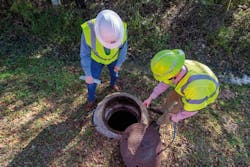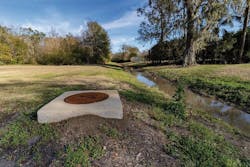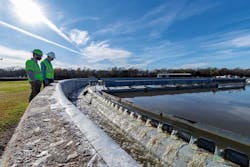Considerations for Creating a Sanitary Sewer Overflow Initiative
Charles Shumate, P.E., is a senior associate at Lockwood, Andrews & Newnam, Inc. (LAN), a national planning, engineering and program management firm. Shumate can be reached at at [email protected]. Molly Villarreal, P.E., is the city engineer for Beaumont, Texas. Villarreal can be reached at [email protected].
undefinedEvery year, the city of Beaumont, which lies on Texas’ coastal plain, is hit by intense thunderstorms with extended periods of rain over large areas. During peak storm events, the city’s wastewater system experiences a surge in flows due to infiltration and inflow (I&I). Additionally, Beaumont has aging wastewater infrastructure that has deteriorated and a flat, low-lying terrain that exacerbates the I&I problem. Due to this perfect storm of age and geography, the city has experienced sanitary sewer overflow (SSO) events over the last few years.
In 2017, the city of Beaumont addressed this issue and entered into a five-year sanitary sewer overflow initiative (SSOI) with the Texas Commission on Environmental Quality (TCEQ). Subsequently, the city hired Lockwood, Andrews & Newnam Inc. (LAN), a national planning, engineering and program management firm, as program manager to evaluate its wastewater collection system and provide recommendations to mitigate SSOs.
Multi-Phased Sanitary Sewer Overflow Initiative
Beaumont’s wastewater system includes more than 700 miles of sanitary sewer, more 70 lift stations, and approximately 9,500 manholes. Given the size of the system and nature of the work to be accomplished, the city and LAN divided the SSOI into three phases. Phase 1 included reviewing existing information, collecting data, and executing field investigations to identify and prioritize major sources of I&I. Keeping in mind the owner’s immediate needs and budget, LAN focused its efforts on manholes during this phase.
“Beaumont has several waterways around and through the city, and key sewer lines run parallel with these drainage channels,” said Steve Gilbreath, P.E., LAN vice president. “After major rain events, operators noticed huge spikes in wastewater flows into their treatment plant. They deduced that flood waters entering the manholes in the system could be a major cause of infiltration and inflows. So, our approach was to follow the water.”
Specifically, LAN prioritized manholes along sewers larger than 12-inches in diameter in the following categories:
- Manholes within the first 6,000 feet of trunk lines entering the wastewater treatment plant as inflow downstream of lift stations impacts the treatment plant faster than upstream flows that may be attenuated by lift station capacity;
- Manholes along a major 72-inch trunk line based on its proximity to major waterways and bayous, number of SSOs, and customer complaints;
- Manholes along trunk lines within 6,000 feet of lift stations discharging to the wastewater treatment plant that impact the timing and quantity of spikes in flow;
- Manholes within 100 feet of a waterway that experienced high levels of inflow; and
- Manholes connected to siphon lines and force mains that tend to have more hydrogen sulfide gases and experience more microbial-induced corrosion.
Manhole Assessment
Using smoke testing, CCTV, and field investigations, the project team observed almost 25% of manholes in the city’s system. Some major observations included:
- Approximately 18% of the manholes inspected were made of brick or a brick throat. Brick manholes have a considerable risk of losing mortar, thus providing greater opportunity for infiltration.
- Nearly 28% of manholes showed signs of active infiltration because of frame and cover deficiencies.
- 49% of inspected manholes were made of fiberglass or have fiberglass walls. Of these fiberglass manholes, 34% had evidence of infiltration.
- 22% of the manholes had debris, sediment and floatables or evidence of surcharge within the manhole.
- More than 10% of the manholes had poorly formed bench and inverts negatively impacting system hydraulics.
- Some of the manholes had cementitious liners with insufficient thickness.
- Some of the previously rehabilitated manholes had an incomplete seal between the liner and manhole and continued to allow more I&I than a well-constructed manhole.
For each manhole, the team also provided an initial technical assessment, the consequence assessment, and its condition assessment. The initial technical assessment included factors such as material, number of surrounding SSOs, and number of customer complaints. This assessment served as an indicator of the manhole’s likelihood to be a source of problem for the system.
The consequence assessment included factors such as sewer size, depth, proximity to waterways or ponding areas, the land use, and structures or pavement around the manhole. This assessment weighed the consequence of failure within the system at that manhole. The condition assessment looked at each component or section of the manhole and its deficiencies. Based on these three assessments, the project team provided an overall weighted condition assessment rating from one to five. A value of five meant that the manhole required urgent attention, a value of four meant that the manhole should be addressed promptly, and a value of three meant that the manhole should be addressed as the budget allowed. Manholes rated one and two are in good condition and would not require further consideration or action.
In addition, the project team included GPS coordinates for the inspected manholes and integrated it into the city’s GIS system. This provided the data needed for reference and rehabilitation measures for future phases of the SSOI.
Current Work & Future Phases
Based on these observations and assessments, the city has implemented a series of work order contracts to rehabilitate its vast network of manholes in order of their priority. To date, 193 manholes have been rehabilitated or replaced. Of these, 72 manholes had a condition assessment rating of four or five. The repairs included cementitious lining, installing CIPP or fiberglass inserts, adjusting/resetting manholes with new frames and covers, curtain grouting, rehabilitating benches and inverts, and in some cases replacing manholes completely.
In addition to manhole rehabilitation, the city is also concurrently implementing other corrective actions as part of its SSOI agreement with the TCEQ. These include cleaning areas of known sources of grease, frequent grease and grit trap inspections, televising lines, and rehabilitating the collection system using methods such as pipe bursting.
Currently, work is underway on Phase 2 of the project. The scope of Phases 2 and 3 includes monitoring flows of sewer lines, building and validating hydraulic models of each metered sewer shed and combining sub-models to further direct investigation and rehabilitation/repair/replacement efforts in the system.
“A big part of this flow monitoring effort is figuring out how much rainfall ends up in the sanitary sewer system,” said Gilbreath. “This data will help us determine how much the manhole rehabilitation efforts helped mitigate I/I and also allow us to focus on deficiencies in other parts of the system.”
Lessons Learned
Through the course of this project, LAN and its subconsultants have learned some important lessons. The following will help any engineering consultant implement a successful multi-year SSOI with a utility:
1. Collaboration is Critical
A collaborative approach between the regulators, owners of the sanitary sewer system, and the engineering consultant is essential. Some SSO initiatives are owner-driven with the owner taking a hands-on approach while others are consultant-driven.
Some cities have council members who represent different parts of the city while others are represented by a single board who make decisions for the entire city. It is critical to understand who the different stakeholders are and form good relationships to include them in the process. This ensures that the planning, scheduling and implementation are seamless.
2. Have a Focused Approach
Begin with a data-driven, focused plan. Once you set up a plan, stick to it, even if you do not know all the answers. Constant shifts or changes in direction will reduce the effectiveness of the SSOI and take up precious time and resources.
3. Track the Project’s Progress
Periodically stop and assess the project’s progress. Are you on track to achieve your goals? Set up key milestones that will allow the stakeholders to check if the plan is working or if it needs tweaking. Write reports once these milestones are achieved and share them with stakeholders.



